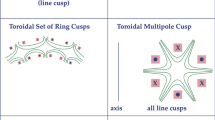Abstract
As is well known, the strong synchrotron radiation recently predicted by Trubnikov and Kudryavtsev1 from a plasma containing a magnetic field at thermonuclear temperatures makes it harder to design a thermonuclear reactor using the deuterium–tritium reaction, and practically impossible to design a deuterium–deuterium reactor. One way to get around this difficulty is to have no magnetic field in the plasma, so that the radiation becomes only a surface phenomenon instead of a bulk one. Of all the magnetic confining geometries at present known, theoretically only one has enough stability to hold a pure (that is, β = 8πnkT/B2 = 1) plasma. This is the picket fence or cusped geometry2. Unfortunately, according to Grad3, the cusps will be very leaky. Attempts have been made to construct geometries to avoid these leaks by closing the cusps on themselves (compare the most interesting papers by Braginski and Kadomtsev4). The same idea was proposed independently by Longmire and me some years ago under the name ‘caulked picket fence’5 (Fig. 1). These geometries involved current-carrying rings, disposed inside a solenoid having a longitudinal magnetic field. Quite apart from the topological impossibility of connecting leads or cooling to these rings without making contact with the plasma, the systems were unstable in their toroidal form because there was no rotational transform6 in the torus axial field.
Similar content being viewed by others
References
Trubnikov, B. A., and Kudryavtsev, V. S., Proc. Second U.N. Int. Conf. Peaceful Uses of Atomic Energy, Geneva, 31, 93 (1959).
Grad, H., Washington Report No. 289, 115 (1955). Tuck, J. L., Washington Report No. 289, 7 (1955). Longmire, C. L., Washington Report No. 289, 11 (1955). Berkowitz, J., et al., Proc. Second U.N. Int. Conf. Peaceful Uses of Atomic Energy, Geneva, 31, 171 (1959).
Grad, H., Inst. of Math. Sciences, NYO Report No. 7969 (1957). Berkowitz, J., et al., Proc. Second U.N. Int. Conf. Peaceful Uses of Atomic Energy, Geneva, 31, 171 (1959).
Braginski, and Kadomtsev, “Plasma Physics and the Problem of Controlled Thermonuclear Reaction”, U.S.S.R., 3, 300 (1958). Kadomtsev, ibid., 4, 353 (1958).
Various classified conferences. Also Longmire and Tuck registration of invention, Los Alamos, February 1957 (unpublished).
Spitzer, L., Physics of Fluids, 1, No. 4, 253 (1958).
Colgate, S. A., and Furth, H., URCL Report No. 5392 (1958).
Author information
Authors and Affiliations
Rights and permissions
About this article
Cite this article
TUCK, J. A New Plasma Confinement Geometry. Nature 187, 863–864 (1960). https://doi.org/10.1038/187863a0
Issue Date:
DOI: https://doi.org/10.1038/187863a0
- Springer Nature Limited
This article is cited by
-
Analysis of Two Fusion Reactor Designs Based on Magnetic Electrostatic Plasma Confinement
Journal of Fusion Energy (2022)
-
Magnetic traps with opposing fields
The Soviet Journal of Atomic Energy (1962)
-
Some notes on thermonuclear reactors
Il Nuovo Cimento (1961)
-
Multipole magnetic field configurations for stable plasma confinement
Il Nuovo Cimento (1961)





